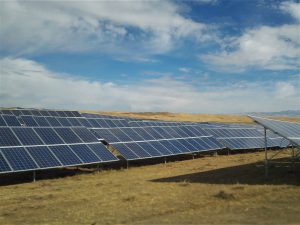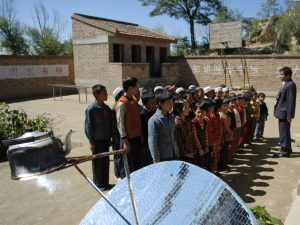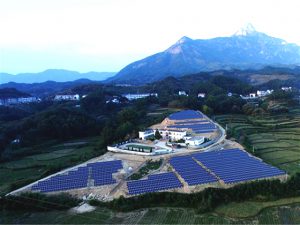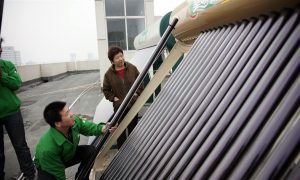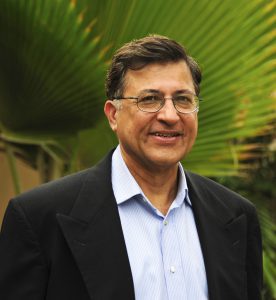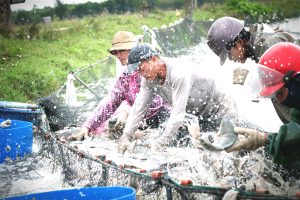The Chinese government is spending 30 billion yuan (US$4.4 billion) to reduce poverty in remote areas by installing solar power. One area seeing investment is Qinghai province in China’s north-west where solar panels are increasingly joining the herders’ tents on the high meadows.
This remote area is 3,000 metres above sea level on average and has just one tenth of the UK’s population despite being three times larger. When China Dialogue visited in November, a 10 megawatt (MW) solar farm in Guinan county in north east Qinghai was nearing completion.
“The government sent someone to check the lightning rods just this morning, we should be able to hook up to the grid and start delivering power in a few days,” said a worker, who asked not to be named.
But our investigation raises serious questions about the practicalities of reducing poverty through solar power generation.
A central policy open to interpretation
The government started its “solar poverty relief projects” programme in April 2015, and it’s now reached all 471 of the Chinese counties designated as poor.
To reduce poverty, the government is funding the installation of distributed solar PV (both rooftop and utility-scale) for two million households, which will receive an income from selling surplus power to the grid.
But in practice, things aren’t so simple.
Two months before the state policy was announced, Qinghai decided to run trials of a similar scheme in thirty villages across eight counties. The province is especially suited for solar power because it gets plenty of sunlight and has a dry climate. The province’s size and vast areas of desertified land also make it suitable for solar installations.
According to the plans for those trials, 8,333 poor households would benefit from the installation of 150MW of solar power. After tax deductions, profits from the sale of power would be paid in full to locals.
Guinan is an almost entirely Tibetan county that’s participating in the trials. It’s hard to get to and rarely visited by tourists. It was chosen as the site for a 10MW solar farm with 556 households expected to share profits of 4,000 yuan (US$583) each per year.
But China Dialogue found the plant managers have their own interpretation of the solar poverty relief policies. One employee, who asked not to be named, explained that the company developing the solar farm will hand out 4,000 yuan a year to local households but will keep additional profits.
“The 4,000 yuan a year subsidy has been made in a single payment to all the households,” another plant employee told China Dialogue. “The company used its own money.”
However, the households that China Dialogue spoke to had no knowledge of payments from the company, and believed that rather than being a local development project, the solar farm was instead part of plans to generate electricity in western China for transmission to the more developed east.
Developer risks
There are also doubts about whether the company developing the solar farm can profit from the project. The 4,000 yuan subsidy for 556 households means expenditure of 2.22 million yuan (US$320,000) every year, not including plant construction costs, staffing and maintenance.
The developer did not respond to multiple requests for comment. It’s unclear though whether the solar farm can sell sufficient power to cover its costs.
One reason for this is that the plant’s income is not guaranteed. Like other commercial renewables projects, the solar farm relies on central government subsidies for clean energy to supplement the income from exporting power to the grid. However, it is now normal for those subsidies to be paid late – often by two or three years.
Meanwhile, industry insiders expect prices for new energy generation to be cut. In November, Jiang Bing, deputy of the State Grid Electric Vehicle Co., said that by 2024 China may no longer subsidise additional clean power generation.
These two issues put pressure on the companies operating solar power poverty relief projects. Wang Fei, who works on such projects for the Hanergy Group, told China Dialogue that the company is not a charity and that profit is the first priority.
The benefits for local governments also appear limited. A village official in Guinan said the local economy doesn’t see much benefit because new energy projects are exempt from local income taxes for three years and pay reduced rates for a further three. This means the local government will not see sufficient income to compensate it for the 380 mu (0.25 square kilometres) of land the 10MW plant will occupy for 25 years.
The project is unlikely to create much employment either. The workers building the solar farm are mostly from outside the area and, once it’s operating, fewer than ten employees will be required to maintain it.
A congested grid
What’s worse, it may be some time before the plant even exports power to the grid. Despite being almost finished and due to start generating power at the end of September, it still lacked a grid connection when China Dialogue visited in November.
The market hasn’t been able to absorb new generation capacity, which has led to high levels of curtailment for wind and solar generation.
Peng Peng, head of the policy consulting department at the China Renewable Energy Industry Association’s Renewable Energy Expert Committee, admitted that “it’s undeniable that there’s an overall surplus of electricity currently, and the market’s ability to absorb new capacity from all sources has fallen.”
The State Grid’s North-West Power Trading Centre estimates that 2017 will see the electricity surplus in the north-west of China continue and that total potential power generation by the end of the year from all generation sources will exceed the highest possible demand.
Surplus generation capacity for the year in the north-west will be 150 billion kilowatt hours – almost one half of the UK’s total annual consumption.
Experts say that large scale deployment of solar power for poverty relief can only exacerbate an already serious problem of oversupply and that the result will be more curtailment of solar power.
Qinghai province is looking for solutions to this problem. In November, the State Grid’s local subsidiary signed an agreement with a number of research bodies, including the China Electric Power Research Institute, on tackling solar power utilisation, transmission, and peak demand management.
Local knowledge
These projects also face knowledge and information gaps, with local residents unsure what the impact will be on the pastures they rely on.
The herders are particularly concerned that the solar farm will spread over the pastures and use land on which they could be grazing livestock. They’re also curious as to whether the new equipment will increase local temperatures.
Although there is no scientific basis for these concerns, they show that people in the area have not had the solar project explained properly; even basic questions such as what the environmental impacts are and where the electricity will be used.
The ecology in Qinghai, which is where the Yangtze, Yellow River and Lancang rise, is vulnerable and both state and provincial policies stress restoration of the environment.
The roads are lined with slogans: “Protect the environment like you protect your eyes”, “Treat the environment as you treat life” and “Clear water and green mountains are as valuable as gold.”
It’s unfortunate that a project combining clean energy with poverty relief, which seems entirely beneficial, is poorly understood by those it is meant to help.
To be fair, the Guinan project is just getting started, but experience from an earlier project in the eastern province of Anhui illustrates the challenges such projects face if they are not well planned.
In the mountains of Anhui some of the villagers’ homes were too run down for rooftop solar panels to be installed, and it is uncertain whether the local power grid can cope with the electricity generated.
Solar poverty relief is an ambitious programme but to be successful projects must accommodate a range of different interests such as households, developers, and different levels of government; whilst coming to market at a time of uncertain electricity demand and likelihood of further changes to China’s complex energy policies.
Even so, Yu Qingchan, energy and climate change projects head at the Global Environment Institute, argues that such projects are unique in having both environmental and social benefits, and so should be encouraged.
